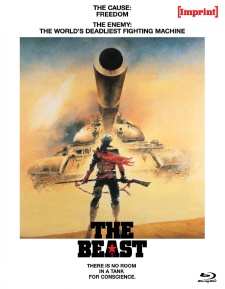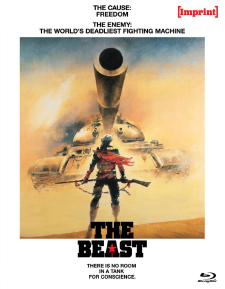Beast, The (Blu-ray Review)

Director
Kevin ReynoldsRelease Date(s)
1988 (August 5, 2022)Studio(s)
Columbia Pictures (Imprint Films/Via Vision Entertainment)- Film/Program Grade: A-
- Video Grade: B-
- Audio Grade: B
- Extras Grade: A-
Review
[Editor’s Note: This is a Region-Free Australian Blu-ray import.]
In the late 1980s, Columbia Pictures was going through major changes. Coca-Cola, who owned the company at the time, was “reorganizing” it, and one of the many casualties was studio head David Puttnam. Prior to his departure, he had greenlit a David vs. Goliath war story based upon the play Nanawatai by William Mastrosimone. The resulting film, The Beast, was dropped like a bad habit by the studio, which by that time, had a new studio head in place that was more interested in making profits than art. Though to be fair, The Beast is by no means an art film, but it’s certainly not a commercial piece aiming for a wide appeal. Its makers had no such plans for it.
The Beast takes place in the early days of the Soviet invasion of Afghanistan in the 1980s, opening with a brutal attack on an Afghan village by a tank, piloted by a group of Russian soldiers who destroy nearly everything and everyone in their sights. However, not all is at seems as there’s more to these soldiers than meets the eye, particularly the driver, Konstantin (Jason Patric), who feels trapped in an unjust war. Also among the group is Kaminski (Don Harvey), who follows his commander’s orders without question, Anatoli (Stephen Baldwin), the youngest and most impressionable of the group, and Samad (Erick Avari), their translator. In charge is Commander Daskal (George Dzundza), an obsessed and disturbed soldier. Finding themselves lost, they’re soon hunted by a group of Afghans, led by Taj (Steven Bauer), who pursue them on foot armed with an RPG-7—the only weapon capable of destroying the tank. After Konstantin nearly causes a mutiny, he’s left behind, whereupon he joins the Afghans whom decide to use his knowledge of the tank in order to take it down, which he agrees to do.
Obviously, The Beast starts off very heavy with unforgiving footage of a group of men attempting to annihilate a village of innocent people, but the hook is getting to know these men and realizing that they’re not just mindless killers. They follow orders, sometimes blindly and to their detriment, especially with a crazed commander at the helm, but they’re constantly questioning every action, sometimes only to themselves. Partly inspired by quotes from Rudyard Kipling, The Beast is a story with many layers to it. The different factions of groups working toward their various goals, some for money and some for revenge, makes for strange bedfellows when they don’t understand each other, sometimes quite literally. A scene of Taj attempting to explain to Konstantin what he wants from him winds up being entirely captivating since neither man speaks the other’s language, but they’re both smart enough to communicate without it.
There are also other facets that viewers may bring to the table inadvertently. The fact that the Russian soldiers speak English without Russian accents may have an unintended effect on American viewers because we see ourselves and our military history within a conflict that we’re not involved with at all, but we recognize the similarities. This is also not the first or last time that Russia invaded a foreign country that chose to fight back with limited means. The past events of The Beast are, unfortunately, not all that dissimilar to current events taking place in Ukraine.
The cast, who worked diligently and exhaustively in the Israeli desert with military advisor Dale Dye for accuracy, give excellent performances all around. Mark Isham’s beautiful score also adds an almost larger-than-life quality to the story and the images. The opening moments of the quiet before the storm with the sun rising and the wild dogs of the desert waking set to ethereal voices and instruments on the soundtrack is breathtaking. This was also the second film directed by Kevin Reynolds, who had just come off of Fandango, and would go on to make Robin Hood: Prince of Thieves, Waterworld, and a personal favorite of mine, The Count of Monte Cristo.
In The Beast, there are no clear answers as to which side is the more deserving of pity. Some may read this into both sides, but in the end, Konstantin’s character winds up with no allegiance to anybody, perhaps not even to himself. He has the look of being lost in his face, not sure what to do once his task is completed. Leaving an audience hanging like that, not to mention slapping them in the face with violence and destruction committed against innocent people right at the start, made it certain that this film wouldn’t pack them in. It was almost shelved and, according to the filmmakers, was released only to a few theaters. But time has been very kind to The Beast. It’s a tough but rewarding piece of filmmaking that doesn’t fit snugly into the typical war drama confines, instead examining the human spirit in the face of needless adversity.
The Beast was shot by cinematographer Douglas Milsome on 35 mm film with Arriflex 35 IIC cameras and spherical lenses, finished photochemically, and presented in the aspect ratio of 1.85:1. Imprint Films brings the film to Blu-ray for the first time with an existing and much older HD master, likely from an interpositive, in 1.78:1 (which is the more theatrically accurate is unclear). While this master’s flaws are obvious, including a soft image lacking obvious grain and featuring occasional scratches, it’s still a nice presentation for when it was originally struck. Saturation may be a tad blown out, but it works well enough for scenes set in a desert, or even in a tank, capturing the intense heat felt by the actors. Blacks are decent and there’s good contrast on display, and the image is mostly stable outside of the opening titles. The film is in need of a restoration from the original camera negative, but for a film that’s not been available on home video all that much, particularly in HD, this is a nice start to get the ball rolling.
Audio is included in English 2.0 LPCM with optional subtitles in English SDH. The film was released in Dolby Stereo, meaning that this is likely a matrix of that audio. It’s a fine track with good balance and imaging. Panning activity is frequent and there’s plenty of atmospheric moments. Mark Isham’s score is given a decent amount of heft and dialogue exchanges are clear and discernible. It’s also worth nothing that the Pashto language spoken by the Afghans has burned-in subtitles. A multi-channel option would have been ideal, but this is very nice stereo track.
The Beast on Region-Free Blu-ray sits in a clear amaray case with an insert featuring fairly generic artwork on the front and a still from the film on the inner sleeve. Everything is housed in a slipcase featuring the original international poster artwork (carrying the original title The Beast and not the international title The Beast of War). The following extras are included in HD:
- Audio Commentary by David J. Moore
- Nanawatai!: Inside the Beast (122:04)
Author David J. Moore takes up audio commentary duties for the film. Although his track is obviously well-researched, he speaks in an almost extemporaneous manner for the majority of the time, with long gaps of silence in between sentences and a very slow speaking style. There’s definitely information to be gained, but it pales in comparison to what comes next, which is a phenomenal new documentary on the making of The Beast by Ballyhoo Motion Pictures entitled Nanawatai!: Inside the Beast. Running over two hours in length, it covers the film from beginning to end, speaking to executive producer Dale Pollock, director Kevin Reynolds, writer William Mastrosimone, actors Steven Bauer, Jason Patric, Don Harvey, Erick Avari, director of photography Douglas Milsome, military advisor Dale Dye, editor Peter Boyle, and composer Mark Isham. Frequent uses of behind-the-scenes stills are used, as well as footage from the film. It not only captures but fully illustrates the hell that the cast and crew went through to make the film, and how it was an unfortunate casualty of a new studio head deeming it not commercial. Many subjects are covered, including shooting the film on location in Israel and using real Israeli actors, two producers making a film who had never made a film before, the extensive and arduous military training that the actors went through, the fact that Kevin Costner and Christopher Plummer were close to being in the film, how influential Platoon was on the project, the brutal heat during shooting, an examination of some of the film’s finest moments, the seemingly authentic firing of tank cannons via well-executed and well-timed special effects, the various effects and stunts, the film’s score, and the film’s fate due to Rambo III. Despite the running time, the documentary flies by and is the most educational and entertaining document on the film.
The Beast is a film that’s not to be approached lightly. It can be too much for some, and indeed it apparently was during test screenings, when many of the people got up and walked out before the opening twenty minutes were finished. But it’s worth sticking with as it has a lot more to say about death and destruction, and the strong opening informs everything about the film that comes after. Imprint’s Blu-ray debut of The Beast offers a decent presentation, but the making-of documentary knocks it out of the park. It’s worth picking it up for that alone.
- Tim Salmons
(You can follow Tim on social media at these links: Twitter and Facebook. And be sure to subscribe to his YouTube channel here.)

